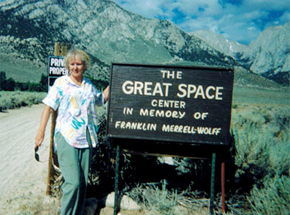Ashrama
The Ashrama / Stone House / Monastery in Tuttle Creek Canyon, Lone Pine, California

View of Ashrama Toward Owens Valley*
In 1928, a recently married couple filled with a mutual dedication toward one another and a dedication toward an Ideal felt within, packed their typewriters and supplies onto burros and hiked into Hunter’s Flats outside of Lone Pine, California. This area is now known as Whitney Portal, and it leads to Mt. Whitney, the tallest mountain in the continental United States. Franklin Wolff and his wife Sherifa set up camp near the falls that fill a small lake and began writing. Franklin began a book on transcendental philosophy, and Sherifa wrote a number of articles on mysticism, as well as a small Sanskrit dictionary.
Given their strong affinity for the area, this two-month camping experience led the couple to decide to spend more time in the mountains. Indeed, they believed that the spiritual center of a country should be near its highest point of elevation.1 The U.S. Forest Service would lease land for extended periods of camping, but only if a structure was built and maintained on the land. Since building permits were not available for the Hunter’s Flats area, the couple explored nearby Tuttle Creek Canyon for a suitable site. Here the beauty of the pine trees, the clear, cold creek, and the remoteness and quiet of the wilderness would provide the atmosphere they desired.
In 1929, Franklin leased a parcel of land from the federal government, and began work on the structure. It would be a building two thousand square feet in size, and in the form of a balanced cross, which was to symbolize the principle of equilibrium. The building was to house a school of the Wisdom Religion, and to serve as a summer camp and retreat. It would be located at eight thousand feet above sea level, overlooking Owens Valley, four thousand feet below.
Franklin was lecturing at this time in cities such as Los Angeles, Chicago, Milwaukee, and Des Moines, and the couple had a home in San Fernando, California. Soon others from around the country became interested in joining in on the construction of the building, and summer vacations were spent in days of hard work and evenings with music and study around the campfire.

Builders of the Ashrama*
The first thing that was needed was a campsite, which was built down by Tuttle Creek, and at one point housed over thirty people. The next task was the process of building a dirt access road, beginning the effort from the top. Trees were cleared and granite was dynamited away. For this latter task, Franklin designed and made special tools for drilling granite. After the summer’s work, a tractor with a small flatbed trailer could make it up the road to the building site. Today, the road has deteriorated into a footpath.

Doroethy Reflecting at the Altar in the Ashrama
The summer of 1930 saw the building site leveled and the four cardinal pillars constructed. Franklin and Sherifa worked long hard hours, and were glad to be joined by others, including some residents of Lone Pine.
In subsequent years, the stonework, stone fireplace, heavy beamed roof, window casings and door frames were all completed. In 1950, before the windows and doors were added, work ceased on the building due to Sherifa’s physical inability to make the trip up to the building site.

The Ashrama*
Throughout the years, the name of the building has changed from Summer Camp to the Rama Sangha School, to the Ajna Ashrama. Lone Pine residents often refer to it as The Monastery; a hiker’s manual refers to it as the Stone House; and it is known by the U.S. Forest Service as the Tuttle Creek Ashram.
In 1963, Tuttle Creek Canyon was designated a Wilderness Area by the Wilderness Area Act, and for some time the future of the ashram was put in doubt. The original lease on the land stipulated that the building must be used for ninety days of each year, but due to the delicate health of Sherifa, it had fallen into disuse for a period of thirteen years. In the interim, vandals had broken in and destroyed or removed everything they could. Since buildings are not normally permitted in federally designated Wilderness Areas, it was proposed that the structure be dynamited into rubble. To avoid this end, Wolff and others periodically cleaned and maintained the building over the years. The U.S. Forest Service evaluated the Ashrama for historical significance in 1980, and concluded that the structure was indeed significant—the Ashrama has been nominated for recognition in the National Register of Historic Places.
There are two video documentaries on the Ashrama available: “The Philosopher’s Stone”2 and “Ashrama Man.”3 The Ashrama has also been the subject of local newspaper articles.
Text by Doroethy Leonard ©1987



